ADFK Blogs
Combat Meditations: Maximizing Hero HP Part 1

Introduction
Hello fellow adventurers its MeanMachine with part 1 of my exploration into the intricacies of how to maximize HP and MP on your DFK Heroes.
I’m taking a theoretical look at HP and MP growth with a focus on preparing for the first iterations of combat in DFK. Out of all the hero stats in DFK, HP and MP have the most complicated growths, as they are dependent on stats that change from level to level. We can get a feel for what are good stats for a hero, but right now it’s more nebulous what makes a good HP and MP at a specific level. I hope to demystify this some and help the community make educated choices about how to cost effectively maximize HP and MP.
To start off, straight from the Hero Base Stats Sheet LINK here are the growth formulas for HP and MP:

There are two major components to the HP and MP growth, the relevant stat value at the time of the level and the type of gain, whose percentages vary on a class by class basis. The interesting thing about these formulas is a stat point is not equal in terms of how much HP or MP it generates for a hero. A hero leveled to 10 will have its level 1 VIT count 10 times for HP growth, whereas its extra VIT gained at level 10 only counts once. For the rest of this blog post, I’m going to focus on all the ways heroes get stats and how they can impact their HP growth, excluding main and sub class for their own dedicated post.
Methodology
Process
Before we start looking at some data, a few words about how I got these results. I wrote some python code to mimic all aspects of heroes level-up and simulated 1000 heroes leveling up to the specified level with a specific set of parameters. This gives us a probability distribution to use to determine how good a heroes rolls have been, and a way to calculate the expected value of a hero’s stats, including HP and MP, for that set of parameters. Since HP and MP have a heavy right tail in terms of outliers in the growth distribution, I’m using the median of the 1000 heroes HP as their expected HP value for the result of their level-ups. The difference in expected values from a set of level-up criteria represents how effective that level-up strategy is at boosting HP.
DFK Hero Assumptions
There are a lot of variables that influence stat growth, so I’ve made some simplifying assumptions that are consistent where not otherwise specified throughout the blog post. I’m looking at a common knight/knight with no extra VIT stat boosts that is leveled up to 15. The assumption is made that the user gives the knight a guaranteed VIT point with each level. There have been a number of hints that 15 is the first level a hero will be able to begin combat, so I’m choosing it as my benchmark to make equal comparisons. I choose a knight/knight because I wanted a matching main/sub class for simplicities sake, and knight is a basic class where it makes sense to push HP growth. Using a common hero avoids the randomness that rarity bonuses introduce into the calculations.
Variables Explored
With those decisions made, there is still a lot left to be analyzed. The rest of this post covers the various things that influences a heros VIT growth: stat genes, VIT gaia’s boons and blessing during level-ups, VIT crystals, VIT stones and tear boosts, and the rarity of the hero. Finally, there is a range of different scenarios presented to showcase the breadth of hp’s a level 15 knight/knight could conceivably have. The two things that are missing from this analysis are the impacts of PJ stat boosts and atonement crystals. I’m aiming this analysis more at how to level up new heroes, so I didn’t try and tackle those more challenging scenarios.
Results
Stat Genes
By stat genes, I’m referring to the green and blue stat boosts that all hero’s have. The analysis of their impact on HP is shown below.
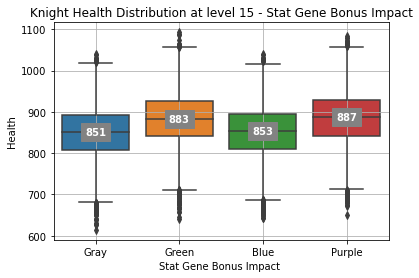
Since this is the style of plot presented throughout the post, lets take a moment and explain what we are seeing here. On the x-axis is the variable I’m changing, in this case the VIT stat gene colors, and on the y-axis is the heroes resulting HP. The plot shows the results as box and whisker plots with the median HP value labeled inside the box. The colored area for each box represents the middle 50% of the HP distribution for heroes, and the whiskers, the lines of the bars, extend 1.5 * the width of the box. Anything below or above that is considered an outlier. Before looking at the change from the stat gene bonuses, its worth noting the size of the potential variation in HP between heroes of the same level leveled the exact same way. While most heroes are clustered in the 800-900 range, its possible to have heroes around 1000 or 700 HP. Those positive outliers should punch above their weight, particular as tanks.
These results clearly show the importance of early VIT stat growth for maximizing HP gain. The +2 bonus from the green stat is responsible for a 32 HP jump between otherwise equivalent heroes. Meanwhile, the blue stat is responsible for a 2 HP difference, which is essentially negligible. Getting a good green stat placement is key for HP growth.
Stones and Tear Boosts
Along the lines of things that are fixed at summons time, one thing that could drive strong HP growth are stone and tear boosts applied at summons time. To get a feel for what matter here, I looked at 8 different cases: a baseline case with no stone or tear boosts, the application of a lesser vigor stone with no tear boosts (lvs0t), lesser vigor stone with 1 lvl 5 VIT tear boosts (lvs1t), lesser vigor stone with 1 lvl 10 VIT tear boosts (lvs2t), lesser vigor stone with 1 lvl 10 VIT tear boost and 1 level 5 tear boost (lvs3t), ), lesser vigor stone with 2 lvl 10 VIT tear boosts (lvs4t), a regular vigor stone (rvs0t) and a greater vigor stone (gvs0t).

What jumps out right away is the difference between applying any kind of VIT stone and no stone. A lesser VIT stone is responsible for an expected 67 HP gain, a respectable ROI for using the VIT stone. Consistent with the impact of the stat genes, the additional VIT points from the tear bonus add about 16 HP per point, with a lesser impact for the added primary growth percentage from the level 10 tear boost. Another interesting thing about these results is that a lesser stone with two level 10 VIT tear boosts is expected to add an equivalent amount of HP as a regular stone with no VIT. The regular and greater stone HP gains are impressive and beat out the 16 HP per VIT point metric due to the heavy primary and secondary permanent growth percentages applied.
Rarity
The final stat variable determined at summon time is the rarity of the hero. I look at all five rarities, keeping the same leveling strategy for each.
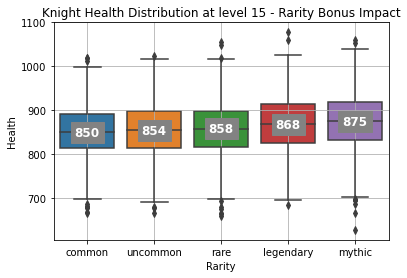
We see that rarity alone does not have a large impact on health growth, the expected difference between a mythic and common is only 25 HP at level 15, with is less than an hit point per level. This indicates that it is primarily user choice, and the luck of the level-ups, that determine how strong a hero’s HP will be. The primary driver of how rarity impacts HP is whether the initial level 1 rarity bonus is included in VIT.
Level-ups- Gaia’s Blessing
Once a hero has been summoned, the player still has a good deal of control over their level-ups, most directly with selecting Gaia’s Boon, a guaranteed +1 to any stat, and Gaia’s blessing, a 50% of a +1 to 2 additional stats. The default leveling strategy for the knights here has been to boon VIT at every level, but here we will show a case where VIT is never prioritized on any level-ups (NoBoon), where VIT is booned for 5 levels and then not selected for any bonus again, (Boon5), where VIT is booned for the first 5 levels and then applied as a blessing (Boon5Bless), and the same logic carried through to a level 10 split and finally applying the guaranteed VIT boost to every level.
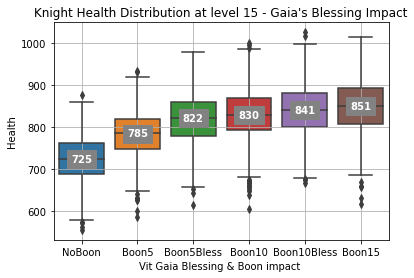
While the chart shows the obvious answer that selecting VIT each time drives the best HP returns, its notable that the boon5 case generates half the HP returns as the boon15 case, and that the boon5bless case returns 75% of the HP returns. For pure tanks it may make the most sense to level VIT maximally, but for other heroes where HP is important but not the primary consideration this suggests that applying VIT boosts early can generate most of the HP returns we want to see in the hero.
Level-ups – Vigor Crystal Use
The other more expensive way for players to influence their heroes level-ups is to use enhancement crystals. To test their impact I ran the simulation which each type of crystal; lesser (lvc), regular (rvc), and greater (gvc) up to a specified level (5,10,15) to see how helpful they could be in boosting HP. The no crystal case (nc) is the baseline to compare the crystal impact against.
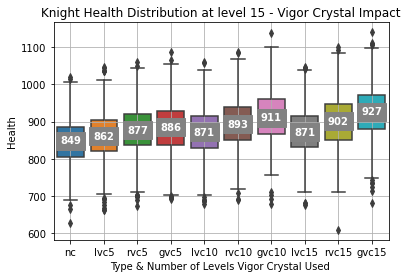
All crystal use is somewhat beneficial here, although what stands out most to me is the strong difference the quality of the crystals make. Using 5 regular vigor crystals on the first 5 level-ups generates more expected HP return at level 15 than using lesser vigor crystals for all 15 level-ups. Given the potential for stat gain elsewhere on heroes, past the first few levels these crystals may not be worth the ROI for HP growth.
Range of HP Outcome
Finally, to get a sense of the range of potential HP outcomes depending on how heroes are leveling, I concocted a set up scenarios as follows:
- The common hero has no VIT stat genes, stones, tear boosts, or level-up crystals applied, and uses gaia’s blessing on VIT for every level-up.
- The uncommon hero has no VIT stat genes, stones, or tear boost, and uses gaia’s boon on VIT with a lesser vigor crystal for the first 5 level-ups before switching to a VIT gaia’s blessing.
- The rare hero has a blue VIT stat gene and uses a lesser VIT stone on summoning. Every level VIT is the boon selected and every level-up uses a lesser crystal.
- The legendary hero has a green VIT stat gene, a regular VIT stone and 1 lvl 10 VIT tear boost applied. Regular vitality crystals are used with each level-up.
- The mythic hero tries to achieve the highest possible HP growth. A greater VIT stone is used with 2 lvl 10 VIT tear boosts, and the hero has a purple VIT stat gene. Greater vitality crystals are used in each level-up.
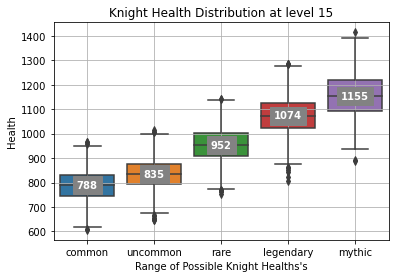
There is a lot of room to distinguish a hero’s HP above the default outcome. For the rare hero that applies affordable steps towards maxing out HP, they can expect to gain 164 more HP than the common hero, which is nothing to sneeze at. People who choose to make the investment into expensive leveling can then double that gap again, which shows you can a good return for investing in HP leveling.
Summary
There are several discrete takeaways from the analysis presented above:
- Rarity is not a strong driver of HP growth.
- Each additional VIT stat point at level 1, whether from stat genes, stones or tear bonus, adds around 16 HP for a level 15 knight/knight.
- Choosing VIT as the +1 guaranteed stat is the best way to drive HP growth through level-ups, though for level 15 booning VIT and then using it a blessing for the rest of the level-ups drives 75% of the HP growth while getting 10 guaranteed stats elsewhere.
- Using better crystals earlier if the more effective way to use crystals to boost HP than consistent lesser crystal usage.
- The strength of the impact of VIT at level 1 is particularly interesting to consider from a gen 0 leveling perspective. It may be worthwhile to push VIT to have the descendants of those heroes be consistently beefier than other heroes of the same class.
Overall, it’s clear that the player has significant control over how much HP a hero will have compared to others in its class and will be another variable for people to consider when building out or buying their combat hero teams. These choices, when combined with the variety of possible main/sub class combinations presented in part2, should help quantify how to get a players target amount of HP on any hero.
MeanMachine
[Feb. 26, 2023]